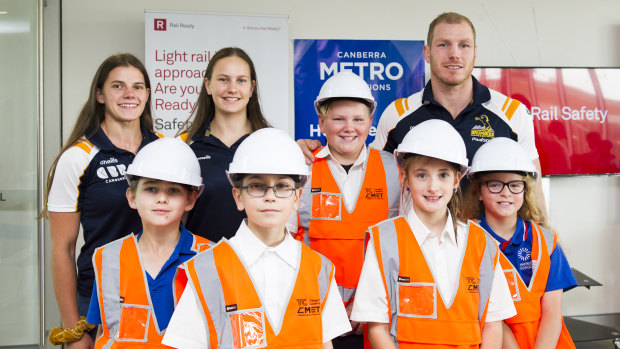This was published 6 years ago
Canberra Metro's light rail safety videos feature some familiar faces
If you've ever wished your fellow passengers would give you a line-out to get off the bus, you might find some joy in Canberra Metro's new light rail safety videos.
Brumbies stars have teamed up with the ACT government to lay out the new light rail rules for Canberrans.
The videos feature centre Tevita Kuridrani, loose forward Tom Cusack, fly-halfs Bayley Kuenzle and Will Goddard along with prop Leslie Leulua'iali'i-Makin.
Brumbies are seen enforcing the new rules for Canberra's tram system, including snatching the pie out of some poor bloke's mouth - no eating on the light rail.
For those eager beavers trying to get on the tram before anyone has a chance to get off, be thankful you're not in the scrum against a pair of rugby players.
In the video, Kuridrani and Leulua'iali'i-Makin barely look like they could get out at the same time, let alone let anyone else squeeze through.
Moments before the two players had picked up one pedestrian, line-out style, to make him cross at a pedestrian crossing.

Brumbies players Darcy Read, Claudia Obst and David Pocock with students from Harrison School at the launch of the Tackle Rail Safety Campaign at the Light Rail Depot. Credit: Dion Georgopoulos
Transport minister Meegan Fitzharris and Metro chief executive Glenn Stockton launched the videos on Friday in front of a crowd of primary school students from Harrison School, with Mr Stockton copping a grilling from the young passengers.
"Are you allowed to pick people up and move them somewhere else," one student said to Mr Stockton.
"That's just for the Brumbies I think," Mr Stockton said.
Another asked when the trams were going live. April 20, Mr Stockton said.
"What if there's no bike racks left?" Mr Stockton said the passenger should wait for the next light rail.
One even asked if they could smoke on board.
"Not that I expect you guys to worry about this too much but there's no smoking on the light rail."
Another asked if they could hang from the hand hold rails. "They're not monkey bars," Mr Stockton said. "Naw," came back the mass of students.
Mr Stockton said while the videos were light hearted, it was still important to get the safety message through to everyone, including kids.
"[Children] are often our most vulnerable when using our service," he said.